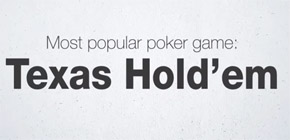Texas Hold'em is by far the most popular format of poker played all over the World. This article will teach you how to play Texas Hold'em.
History
The general consensus

is that
Texas Hold'em had its origins in Texas in the early 1900s. It was first introduced to Las Vegas in 1967 where it was modified from its original form so that Aces were now high instead of low.
It became the main event of the newly established World Series of Poker in 1972 where there were 8 entrants. By 1982 there were over 100 entrants, and by 1991 over 200.
The popularity of NLHE continued to grow after the inception of online poker in 1998. However, one event singlehandedly initiated the biggest explosion of poker, often named “the poker boom”. It occurred in 2003 when an unknown online qualifier by the name of Chris Moneymaker won the WSOP. By 2004 interest in the Series had tripled. Regular every-day people now saw it was possible to make it big if they had just a few dollars in their online account.
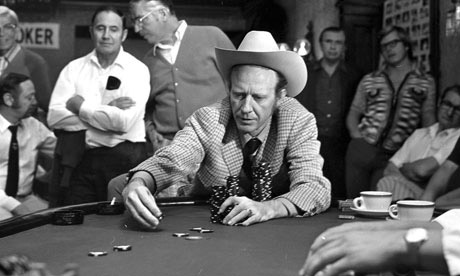
To date, Texas no-limit hold'em remains the most popular poker variant, although admittedly the “Texas” part is often omitted these days. Generally if someone tells us they are playing poker we should assume they are referring to No Limit Hold'em. The majority of films with poker scenes depict no-limit hold'em, whereas older movies would typically show stud or draw games. The 1998 cult classic “Rounders” also played a big role in boosting the popularity of poker as we know it.
"Poker boom" started after an online qualifier, Chris Moneymaker, won WSOP Main Event in 2003
Texas Holdem Poker Rules
Keeping Score
Similar to all other variants of poker each player starts with a number of “chips”. These are small circular bits of plastic or clay used for betting and keeping score. Generally these chips can be traded in for their monetary value after the game is over.
The objective of any poker game – to win your opponents chips. In a poker tournament, you win by accumulating all of the chips on the table.
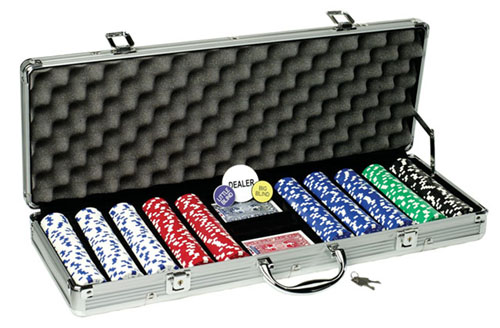
Blinds/Position
A poker table can consist of anywhere between 2 and 10 players, with one player being the dealer. The dealer will have a button indicator beside him, which is a plastic disc marked “dealer”. This moves round the table clockwise after every hand to indicate whose turn it is to deal.
In a home game the player with the dealer button will generally shuffle and deal the cards, although in a casino this job is performed solely by a designated dealer. The dealer button will still be used in such cases to indicate the various positions players occupy at the table.
To create a starting “pot”, certain players must make mandatory blind payments before any cards are dealt. These players are located immediately to the left of the dealer button: firstly, the “small-blind” (SB) position, and to the left of the SB is the “big-blind” (BB). Both these players must make the mandatory blind payments.
In most games the BB blind be will be twice as much as the SB blind is, although this can vary depending on the casino.
The best position at the table is generally considered to be the BTN, while the worst is considered to be either the SB or UTG
Immediately to the right of the “button” (BTN), is the “cut-off” (CO), followed by “middle position” MP, and “under-the-gun” (UTG). Specifically on a 9 or 10 handed table, the position directly to the right of the CO may be referred to as the “hi-jack”, while the position to the right of the “hijack” may be referred to as the “lo-jack”. Generally the main difference between a 6-handed table and a 10-handed table is that the 10-handed table will have 3 middle positions and 3 under-the-gun positions whereas a 6-handed table has only one of each.

Position is very important in NLHE because it determines the order of betting. The best position at the table is generally considered to be the BTN, while the worst is considered to be either the SB or UTG.
Playing a Hand of Poker
Now that we have our players all set, let's get into playing a hand of poker!
The game-flow is broken down into rounds known as “streets”. Each hand of Texas hold'em is broken down into 4 streets referred to as “preflop”, “flop”, “turn” and “river”.
On each street, a round of betting takes place. If more than one player is left in the hand by the river we reach what is referred to as “showdown”. All remaining players show their hands and the best hand takes the chips or “pot” that is in the middle.
Round 1 – Preflop

Before any action takes places, all players are dealt 2 “hole-cards” starting with the player on the dealers left and moving clockwise. These cards are kept secret and should not be shown to any other player. By the time the cards are dealt, the SB and BB have already posted their mandatory blind payments.
Before any additional cards are dealt a round of betting takes place. UTG (to the immediate left of the BB) is first to act, and we move round the table clock-wise. BB will be last to act preflop. Once all the betting has taken place we move on to the next street. (More on how the betting works later.)
"Hole cards" are to be kept secret and not shown to anyone.
On each street players have the option to bet/call/raise or fold. Depending on the situation not all of these options will be valid and this will be fully described below after the betting rounds.
Postflop
The betting order changes slightly on the flop. On each street, SB will be first to act, with BTN now acting last. This is why BTN is considered the most favourable position on the table. The BTN gets to see what all other players do before he acts.
Round 2 - Flop
Before any betting takes place, three “community cards” referred to as the “flop” are dealt face-up in the centre of the table. All players may make use of these cards to construct a 5-card hand along with one or both of their hole-cards.
Again, players may 'Check', 'Bet', 'Fold' or 'Raise'.
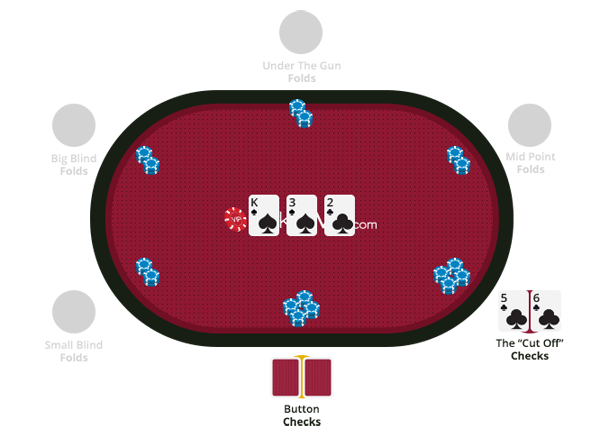
Round 3 - Turn
After this round of betting is complete, an additional community card is dealt face-up, referred to as the “turn” card. Another round of betting takes place.
Round 4 – River
Finally, one last community card is dealt face-up, referred to as the “river” card. A final round of betting takes place. After this round of betting any remaining players must reveal their hole-cards. The player with the strongest hand takes the pot.
Showdown
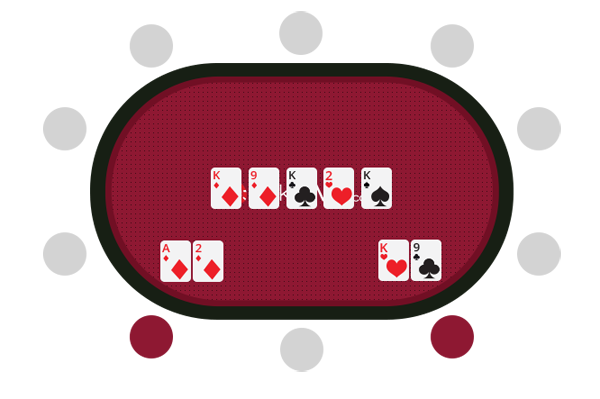
Betting
The following is a list of the available actions players may take during the betting round.
Bet – A player wishes to bet some of his chips on the outcome of the hand. Generally betting implies that no-one has acted yet on the current street (And therefore cannot be performed pre-flop, since a blind bet has already been placed). Players should place their wager chips into the centre of the table or “pot”. This is done automatically online.
Check – A player wishes to take no action. The game-flow passes to his left where it is now the next players' turn to act. Note that checking is only a valid option when no bet has been made on the current street (and therefore cannot be performed pre-flop). If someone has already made a bet, the only valid options are “call”, “raise” or "fold".
Call – Call is a valid option when a player who has acted before us has made a bet on the current street. In order to continue with the hand we need to match the bet made by the previous player. If the player before us bets 5 chips, we need to place 5 chips into the pot to stay in the hand. Assuming we don't wish to continue with our hand it's necessary that we “fold”.
Depending on action before them, every player has an option to either check, bet, call, fold or raise
Fold – Assuming we are facing a bet from another player that we don't want to match we have the option to discard our hand. When we fold our hand we agree that we are no longer involved in the hand and have no possible way of winning. Our folded hand will generally be returned face-down to the dealer.
Raise – Raise is an option when a player before us has made a bet. We can increase the bet by “raising” to a higher amount of chips. Players acting after us, including the original raiser, must now call, fold, or re-raise. A round of betting will only end when either one player calls a bet, hence closing the action, or he decides to fold.
Players may continue re-raising each other until one player is “all-in”, at which point the other player may only call or fold. It is not possible to re-raise a player for more than the chips they have at the table. Sometimes in movies we see players re-raising each other for watches, phones, houses and private yachts. In pretty much any casino game, players may only wager what they bring to the table ("table stakes"). While a standard “bet” may also be considered a “raise”, it's common to only use the terminology “raise” when a player before us has already made a wager and we wish to increase the size of the wager.
Texas Holdem Hand Rankings
Naturally the above information is not of too much help if we don't understand how to read the strength of our hand. The following is a list of the hand rankings used in NLHE (and many other popular poker variants). Keep in mind that all hands in No-Limit Hold'em are comprised of 5 cards.
For example, assuming that we hold the same “pair” as another player, the strength of the remaining 3 cards or “kickers” will be used to determine who wins the pot. In a situation where these kickers are identical then the pot is a tie and will be split up evenly between the winners.
Royal Flush – T, J, Q, K, A all of the same suit. This is the strongest hand in NLHE and is made quite rarely as a result.
 Straight Flush
Straight Flush – 5 cards in a row, all of the same suit. For example 7,8,9,T,J all of hearts.
 Four-of-a-Kind
Four-of-a-Kind – 4 cards of the same value. For example QQQQ, or 8888. Usually referred to as “Quads”
 Full-House
Full-House – 3 cards of the same value along with 2 cards of the same value. QQQ44, or KKKJJ. Often referred to as a “boat”.
 Flush
Flush – Any 5 cards of the same suit.
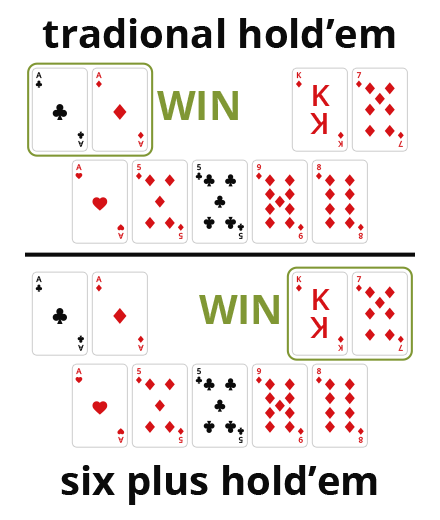 Straight
Straight – Any 5 cards in ascending order. For example 7,8,9,T,J but not all of the same suit.
 Three-of-a-Kind
Three-of-a-Kind – Three cards of the same value, for example KKK, or QQQ. Since all hands are 5 card hands the other two cards are referred to as “kickers”. KKKT7 loses to KKKAT for example. Commonly referred to as “trips” when made with one hole-card and a “set” when made with both hole-cards as in the case of holding a “pocket-pair” such as KK.
 Two-Pair
Two-Pair – 2 cards of the same value along with 2 other cards of the same value. For example KKQQ5 or JJ447.
[image:=pokerimage]https://www.pokervip.com/uploads/backend/twopair.png[/image]
One-Pair – 2 cards of the same value. For example TT523, or QQ764.

Straight flush beats quads every day of the week and twice on Sunday
Why Play No-Limit Hold'em
Firstly, it is very easy to learn. The rules may seem complex initially, but within a few hands you will quickly realise that the concept is extremely simple. However the game itself is no joke. Playing a strong strategy is something that can take a lifetime to master.
One thing that sets no-limit aside from other variants is the betting structure. Many poker variants make use of limited betting structures meaning there is a maximum amount that can be bet at any time. NLHE removes this limit meaning that any player can potentially bet all of his chips at any given moment. This makes NLHE faster and more exciting than other poker variants.
Also while initially the game seems about making big hands, nothing could be further from the truth. It doesn't take long to realise that we can win pots by pretending we have a hand when we don't. This is referred to as “bluffing”. The thrill of making a big bluff and scooping a huge pot is what drives many to the game.
What makes NLHE exciting is that any player can bet all of his chips at any given moment.
It's also important to remember that NLHE is only partly a game of luck. Ultimately it is a game of skill. While good players go on losing stretches they will always come out on top again if they are skilled enough. The outcome of any given hand has more to do with luck than skill, but over the course of thousands of hands, the best players have a tendency to show profit. For those skilled enough, NLHE can be a lucrative source of income, whether done as a hobby or as a profession.
NLHE tips for beginners
- Be selective with your starting hands. We should generally be playing the top 25% of hands only. Perhaps only the top 20% at the start.
- Use your position. We should play more hands from BTN and less hands from UTG.
- Bet in accordance with the pot. Rather than thinking of our bets in terms of chips or their monetary value, focus on betting a certain percentage of the pot. This means that as the pot grows our bet-sizing will increase.
- Slowrolling. This is the practice of taking a long time to call on the river when we clearly have the best hand. Taking a long time on earlier streets with a strong holdings is a good deceptive tactic. Taking a long time on the river when we are closing the action is consider bad etiquette and will make you unpopular at the tables.
- String-betting. Not a huge issue for online players since this is automated. If our intention is to raise our opponent we say “raise” and put that amount in the pot in one smooth motion. We don't do as some movies depict “I call your bet <puts chips into pot>, and raise you another 20 <puts chips into pot>. If you attempt to do this in a casino your first action will stand and be treated as a call.
- Showing folded hands. Never show anyone your hand after you have already folded. This is unfair and will influence the decision the remaining players will make. It could also get you a penalty in a casino. Feel free to show your hand after the game is over, but remember that you are not obligated to show your hand unless you made the last aggressive action before showdown. So if someone makes a big bet on the river, and we call, our opponent must turn his hand over first. If we lose we then have the right to “muck” our hand and not show anyone; so don't let anyone bully you into showing your cards unless you have already agreed on it beforehand. Assuming we have the best hand and want to take the pot, we must always show of course.
- Trash Talk – While even some professionals engage in this practice it is considered bad etiquette to berate or insult your opponents. One mark of a true professional is being able to take beats and losses with grace
Want to learn more poker strategy? 













